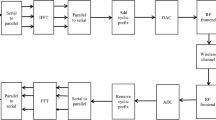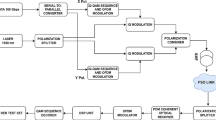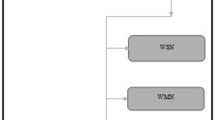Abstract
Vehicle to everything (V2X) communication supports vehicle to anything communication for vehicle safety and cooperative Intelligent Transport System in vehicular environments. IEEE 802.11p modem has been developed and applied for V2X communication system. V2X radio channel has multipath fast fading due to moving vehicles and surrounded road structure. We proposed a new DFCE-AD which combines DFCE and antenna diversity for OFDM reception and analyzed the performance improvement in multipath fading channel. Through computer simulation, SNR gain of DFCE-AD over DFCE for QPSK modulation is approximately 6 dB at PER = 10%. In other word, PER of DFCE-AD is improved over that of DFCE by about 20% at SNR = 10 dB. This result will be applied for the short sized packet and low order OFDM modulation in vehicular multipath fading channel.
Similar content being viewed by others
Avoid common mistakes on your manuscript.
1 Introduction
As Information and Communication Technology (ICT) is advanced, vehicles are connected to surrounding vehicles and road infrastructure by using wireless connectivity. The wireless connectivity enables vehicles to recognize neighboring vehicle’s moving status or road’s situation and provide vehicle safety and Cooperative Intelligent Transport System (C-ITS). Thus vehicle’s wireless connectivity will contribute on reduction of traffic accident, congestion and CO2 emission [1, 2]. V2X connectivity provides vehicle to anything communication in urban or high way environments. V2X radio channel has multipath fast fading due to moving vehicles and surrounded road structure [3,4,5,6]. In dense urban intersection, a public bus and a small car may be mixed in moving and vehicle to vehicle wireless channel may have Non Line of Sight propagation with multipath propagation. Also in highway driving, vehicle to vehicle channel may have deep fading due to the reflected interference of the neighboring heavy truck or fast fading due to the high relative speed in moving vehicles with the opposite direction. There was much research on V2X radio channel model. Georgia technology has published 5.9 GHz radio channel modeling through experiment and theoretical analysis. And V2X radio channel has Non Line of Sight (NLOS) multipath fading characteristics in vehicular environment [4,5,6]. NLOS multipath fading channel model can be modeled as Jakes channel model [7,8,9].
Wireless Access in Vehicular Environments (WAVE) communication adopted Orthogonal Frequency Division Multiplexing (OFDM) modulation with 10 MHz channel spacing and increased RF power for the extension of radio coverage. It supports Binary Phase Shift Keying (BPSK), Quadrature Phase Shift Keying (QPSK), 16 Quadrature Amplitude Modulation (16 QAM) or 64 Quadrature Amplitude Modulation (64 QAM) and convolutional coding scheme [10, 11]. The received OFDM signal through NLOS multipath fading channel will have fast change in the amplitude and phase term. To improve the performance of OFDM reception, many channel estimation techniques have been studied. The pilot symbol may be inserted into the data symbol to estimate fast change of channel phase [12, 13]. And the position of pilot signals may be changed [14]. Proposed schemes may improve the channel estimation. However, they need to change the signal form of transmitted OFDM signal. The channel estimation schemes are proposed; channel estimation by using inter-symbols averaging in time domain, channel estimation by using inter-symbols correlation in time domain, channel estimation by using data symbol feedback [12,13,14,15,16].
The decision feedback channel estimation scheme has excellent estimation performance in fast fading channel among many channel estimation techniques. In this paper, we propose a new channel estimation method using Decision Feedback Channel Estimation with Antenna Diversity (DFCE-AD). For the given OFDM signal format, we analyzed the PER performance in the multipath fading channel if conventional Decision Feedback Channel Estimation (DFCE) scheme is applied. Also, we analyze PER performance of proposed DFCE-AD scheme.
In the Sect. 2, we introduce V2X OFDM system model. It consists of OFDM transmitter, multipath fading channel model and receiver. In Sect. 3, the proposed channel estimation scheme is described. In Sect. 4, computer simulation and performance results are discussed. Finally the conclusions are summarized in Sect. 5.
2 V2X OFDM System Model
The V2X OFDM system consists of OFDM transmitter, multipath fading channel model and receiver as shown in Fig. 1. Packet Data Generation sends randomly generated data to OFDM Modulator and Packet Error Count measures the number of packet error of the received packet data from the receiver. OFDM Modulator generates OFDM modulated signal and insert training sequence for initial packet detection and synchronization [10]. The modulated signal X will be distorted in amplitude and phase through multipath fading channel. The multipath fading channel can be modeled as Tapped Delay Line (TDL) filter. The received signal Y through multipath fading channel will be input to OFDM demodulator to recover data \(\hat{X}\).
OFDM demodulator in Fig. 2 detects the start time of received packet by correlating the received training sequence with the internal reference sequence. After packet detection and Fast Fourier Transform (FFT) processing, Least Square (LS) Estimator generates Channel Estimate \(\hat{H}\) by using the reference signal of the received signal. The OFDM signal of IEEE 802.11p has a reference signal in the head part of packet and does not have continuous reference signal. Therefore, the recovered data symbol \(\hat{X}\) is mapped and scrambled to be used as the continuous reference signal for channel estimation. LS estimator is applied because it is simple to implement and other optimal estimator such as MMSE may be applied.
The recovered signal will be simply expressed by the Eq. (1).
3 Proposed Decision Feedback Channel Estimation with Antenna Diversity (DFCE-AD)
The OFDM signal of IEEE 802.11p has a reference signal in the head part of packet and only supports initial channel estimation. The DFCE scheme is an effective method to provide continuous channel estimation. We propose a new DFCE-AD which combines DFCE and antenna diversity because antenna diversity is known as an effective way for vehicular fading channel. In this scheme, initial channel estimation and the continuous channel estimation is the same as the conventional scheme except for the digital combining using antenna diversity. The digital combining may have equal gain combining, path selection combining and maximal ratio combing and it is well known that selection combining or maximal combining has a good performance in multipath fading channel. And the channel estimation and digital combining are processed by every OFDM symbol.
The recovered signal will be simply expressed by the Eq. (2) and the below Fig. 3 shows system configuration of DFCE-AD scheme.
4 Performance Analysis
The performance analysis has been conducted by computer simulation. The simulation modeling consists of packet generation, OFDM signal and multipath fading channel, the receiver and packet reception in Table 1. In the performance analysis, packet size and mobility are considered as the key simulation parameters because DFCE-AD algorithm has data feedback channel estimation type and impacted by packet size and multipath mobility.
Packet generation will be able to generate short packet or long packet because vehicle safety applications has short packet which is an order of 300 bytes and IP applications has long packet which is an order of 1000 bytes. OFDM signal format will have BPSK, QPSK, 16 QAM and 64 QAM scheme and multipath fading channel will have Doppler spectrum in 140 km/h or 400 km/h moving condition. Practically 140 km/h mobility considers highway driving and 400 km/h assumes that two vehicles are moving in the opposite direction and the relative speed will be doubled.
At the receiver, we have applied DFCE or DFCE-AD scheme. And we calculated PER for the given signal-to-noise ratio (SNR).
Computer simulation has taken 10,000 iterations to calculate PER under the given conditions by using MATLAB.
Figure 4 shows performance result of conventional DFCE for modulation level BPSK, QPSK, QPSK and 64 QAM in the condition of packet size 300 bytes and 140 km/h vehicular mobility. The required SNR at PER = 10% is analyzed because the minimum PER of IEEE 802.11p standard is specified to 10%. To meet PER = 10%, SNR = 15 dB for BPSK, SNR = 16 dB for QPSK and 16 QAM, SNR = 25 dB for 64 QAM are approximately required. And Fig. 5 shows performance result of proposed DFCE-AD for modulation level BPSK, QPSK, QPSK and 64 QAM in the same condition of Fig. 4. To meet PER = 10%, SNR = 8 dB for BPSK, SNR = 10 dB for QPSK, SNR = 12 dB for 16 QAM, SNR = 19 dB for 64 QAM are required. From Figs. 4 and 5, SNR gain of DFCE-AD over DFCE will be approximately 7 dB in BPSK, 6 dB in QPSK, 4 dB in 16 QAM, 6 dB in 64 QAM. Figure 6 shows performance improvement of DFCE-AD over DFCE for QPSK modulation in the condition of packet size 300 bytes and 140 km/h vehicular mobility. From the Fig. 6, SNR gain of DFCE-AD over DFCE is approximately 6 dB at PER = 10%. And PER of DFCE-AD is improved over that of DFCE by about 20% at SNR = 10 dB.
We analyzed the impact on the performance of DFCE-AD which is related to the packet size and the mobility. As for the sample cases; 140 km/h or 400 km/h, 300 bytes or 1000 bytes, the performance is analyzed.
In Fig. 7, SNR of 400 km/h mobility at PER = 10% will be degraded over that of 140 k/h mobility by 6 dB. In other words, PER performance of 400 km/h mobility at SNR = 16 dB is degraded over that of 140 km/h mobility by about 10%.
In Fig. 8, SNR of 1000 bytes at PER = 10% will be degraded over that of 300 bytes by about 4.5 dB. In other words, PER performance of 1000 bytes at SNR = 16 dB is degraded over that of 300 bytes by about 15%. This tendency shows that the performance of DFCE-AD is directly related to the mobility and packet size.
From the computer simulation, the proposed DFCE-AD has have SNR improvement on the conventional DFCE scheme for packet transmission of the low order modulation. And the PER of the short sized packet or low order modulation signal is not impacted by the vehicle mobility. However, PER of the long sized packet or high order modulation signal is impacted.
DFCE-AD algorithm had been implemented into ASIC logic and performance test had been conducted at 100 km/h driving in highway environment. When OFDM transceiver was mounted on test vehicle and 8000 packets with 1000 bytes were transmitted, PER at the receiver was counted for DFCE and DFCE-AD schemes respectively. Field test result showed that PER of DFCE-AD is better than that of DFCE in highway environment by about 20%.
5 Conclusion
V2X communication supports vehicle to anything communication for vehicle safety and cooperative Intelligent Transport System in vehicular environments. IEEE 802.11p transceiver has been used for V2X applications.
We proposed DFCE-AD in IEEE 802.11p ODDM reception and analyzed PER performance through computer simulation and filed test. From our analysis, there is the performance improvement of DFCE-AD over DFCE by about 6 dB at PER = 10% for the low order modulation such as BPSK, QPSK and 16 QAM. This means that there is PER improvement by 20% at the given SNR. Also it was verified that the proposed DFCE-AD has PER improvement by about 20% over DFCE for QPSK modulation through the field test.
Change history
20 August 2018
There was incorrect information in the acknowledgement in the original publication. The correct information is shown below.
References
Vehicle-to-Vehicle Communications: Readiness of V2V Technology for Application, NHTSA, August, 2014.
TNO, “Overview of standards for first deployment of C-ITS”, Nov. 2014.
Sen, I., & Matolak, D. W. (2008). Vehicle–vehicle channel models for the 5-GHz band. IEEE Transactions on Intelligent Transportation Systems, 9(2), 235–245.
Acosta-Marum, G., & Ingram, M. A. (2007). Six time-and frequency-selective empirical channel models for vehicular wireless LANs. IEEE Vehicular Technology Magazine, 2(4), 4–11.
Acosta-Marum, G. (2007). Measurement, modeling, and OFDM synchronization for the wideband mobile-to-mobile channel. Ph.D. dissertation, Georgia Inst. Technol., Atlanta, GA.
Wang, C. X., Cheng, X., & Laurenson, D. I. (2009). Vehicle to vehicle channel modeling and measurements: Recent advances and future challenges. IEEE Communication Magazine, 47(11), 96–103.
Jakes, W. C. (1994). Microwave mobile communications. New York: IEEE Press.
Sampei, S. (1997). Applications of digital wireless technologies to global wireless communications. Upper Saddle River, NJ: Prentice-Hall.
Hiroshi, H. (2002). Simulation and software defined radio for mobile communications. Norwood: Artech House.
IEEE 802.11p. IEEE Standard for Information Technology Telecommunication and Information Exchange between Systems Local and Metropolitan Area Networks Specific Requirements. Part II: Wireless LAN MAC and PHY Specifications Amendment 6: Wireless Access in Vehicular Environments, July 22, 2014.
ETSI ES 202 663, Intelligent Transport Systems (ITS); European profile standard for the physical and medium access control layer of Intelligent Transport Systems operating in the 5 GHz frequency band, V.1.1.0, 2010.
Kim, S. I., Oh, H. S., & Choi, H. K. (2008). Mid-amble aided OFDM performance analysis in high mobility vehicular channel. In Proceedings of intelligent vehicles symposium, 2008 (pp. 751–754).
Cho, W., Kim, S. I., Choi, H. K., Oh, H. S., & Kwak, D. Y. (2009). Performance evaluation of V2V/V2I communications: The effect of mid-amble insertion. In Proceedings of 1st international conference on wireless communication, vehicular technology, information theory aerospace electronic systems technology (pp. 793–797).
Fernandez, J. A., Borries, K., Cheng, L., Vijaya Kumar, B. V. K., Stancil, D. D., & Bai, F. (2012). Performance of the 802.11p Physical layer in vehicle-to-vehicle environments. IEEE Transactions on Vehicular Technology, 61(1), 3–14.
Zhao, Z., Cheng, X., Wen, M., Jiao, B., & Wang, C.-X. (2013). Channel estimation schemes for IEEE 802.11p standard. IEEE Intelligent Transportation Systems Magazine, 5(4), 38–49.
Alexander, P., Harley, D., & Grant, A. (2010). Cooperative intelligent transport system: 5.9 GHz field trials. In Proceeding of IEEE (pp. 1–23).
Author information
Authors and Affiliations
Corresponding author
Additional information
Publisher's Note
Springer Nature remains neutral with regard to jurisdictional claims in published maps and institutional affiliations.
This work was supported by Electronics and Telecommunications Research Institute (ETRI) grant funded by the Korean government [17ZS1500, High Speed V-Link Communication Technology Development for Real Time Control of Autonomous Driving Vehicle].
Rights and permissions
Open Access This article is distributed under the terms of the Creative Commons Attribution 4.0 International License (http://creativecommons.org/licenses/by/4.0/), which permits unrestricted use, distribution, and reproduction in any medium, provided you give appropriate credit to the original author(s) and the source, provide a link to the Creative Commons license, and indicate if changes were made.
About this article
Cite this article
Oh, H.S., Kang, D.W. Performance Analysis on Channel Estimation with Antenna Diversity of OFDM Reception in Multi-path Fast Fading Channel. Wireless Pers Commun 103, 2423–2431 (2018). https://doi.org/10.1007/s11277-018-5919-7
Published:
Issue Date:
DOI: https://doi.org/10.1007/s11277-018-5919-7












